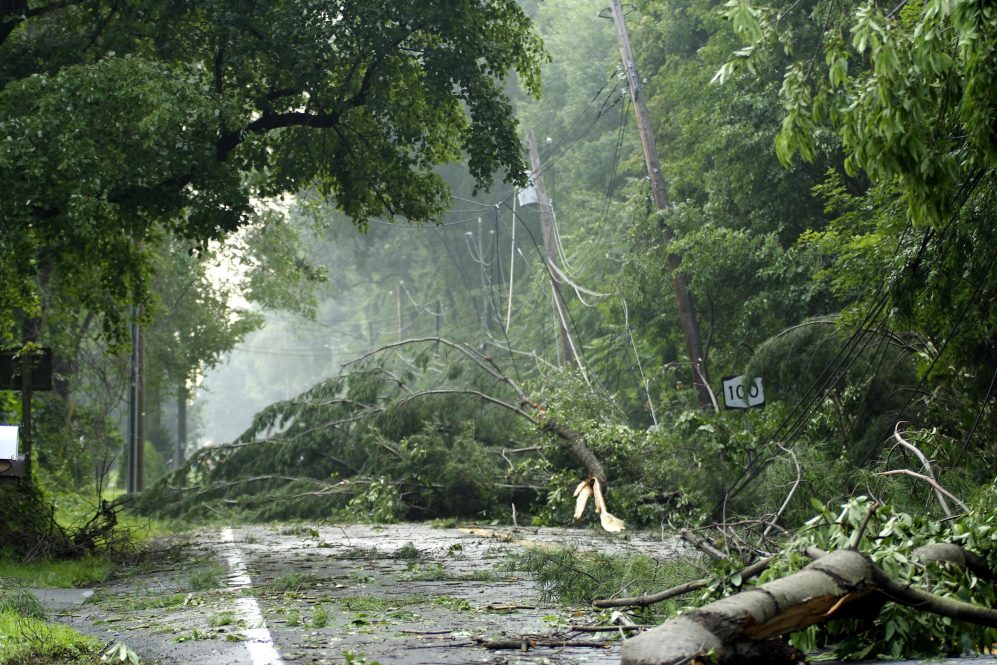As extreme weather events grow more frequent, UConn and its partners are working to make the northeastern power grid more resilient.
UConn is leading a collaboration with the University at Albany and several other partners lending their respective expertise in outage prediction and meteorology. The federal Department of Energy (DOE) is funding the effort through two significant grants totaling $2.63 million.
“The Northeastern United States is the exemplar regional case for energy transition to electrification and renewables while highly exposed to risk of disasters from natural hazards, such as hurricanes, severe Nor’easters, and winter storms,” says Emmanouil Anagnostou, Interim Director of the UConn Tech Park and Director of the Eversource Energy Center. “These risks are projected to increase in severity and frequency across the region, as are heat waves, precipitation, and drought, creating unique challenges to power grid resilience.”
“We are thrilled to partner once again with UConn, along with other researchers and industry innovators, to help strengthen the power grid for vulnerable Northeast communities,” says Chris Thorncroft, director of UAlbany’s Atmospheric Sciences Research Center and Center of Excellence in Weather & Climate Analytics. “This work will advance research and cutting-edge technologies to improve energy industry efficiency and reliability in the face of a rapidly changing climate and global transition to clean energy sources.”
Early this year, the DOE called for submissions for Grid Resilience Analysis and Climate Change Impacts (GRACI) funding. Public, private, and nonprofit institutions and companies were asked to accelerate analysis of regional climate change threats and resulting challenges to grid resiliency. The grants, announced on Thursday, June 27, total $4.6 million nationwide.

“Keeping the lights on for communities across the country is a primary goal of the Grid Deployment Office (GDO),” saysMaria Robinson, Director of the Grid Deployment Office, U.S. Department of Energy. “GDO provides multiple financial mechanisms and investment programs to support state efforts, but this is not always enough. Each geographic region is different, with varying extreme weather impact challenges and grid resilience goals. This program will allow states to leverage existing tools, methods, and processes to help identify a solution that works for their individual region, while providing the highest level of community benefits.”
Through the two projects funded for the Northeast, UConn and the Eversource Energy Center will lead one and assume technical lead overseeing four of seven tasks in the second project led by Pointerra3D.
In the first GRACI project entitled “Community co-design of Resilient Energy Solution Technology,” UConn and UAlbany will work together to provide risk assessments and investment guidance to states throughout the Northeast. UConn will utilize its outage prediction model to create the grid resilience assessment, combining expertise in climate research and socioeconomic risk to guide recommendations.
UAlbany will use numerical prediction models to identify key trends throughout the region for different climate hazards and scenarios.
UConn and UAlbany are no strangers to collaboration. The two universities comprise the Center for Weather Innovation and Smart Energy Resilience, designed to help corporate partners and government agencies to work with to conduct high-impact research, drive innovative technology development, and develop a skilled workforce.
“These projects highlight the continuing partnership between UAlbany and the University of Connecticut, bringing together preeminent expertise in climate and energy,” says Jeff Freedman, research faculty at UAlbany’s Atmospheric Sciences Research Center. “We look forward to working together to identify and recommend efficient pathways for states and utilities to follow to ensure a just and dependable energy future.”
In the second GRACI project entitled “Wind Impact Study for Power Resilience (WISPR)”, UConn and UAlbany will work with Cornell and Pointerra3D (a 3D visualization and data analytics company) to simulate investments at Eversource, Avangrid, and National Grid service territories aimed at enhancing grid resilience, including hardening assets and managing problematic vegetation.
Pointerra will deploy light detection and ranging (LiDAR) technology, and data imagery to generate digital twins of circuits in the respective territories. UConn will use these data along with asset information, and historical outage data to develop a dynamic risk assessment model to identify patterns between vegetation management and power outages. UConn will also integrate future climate change projections and vegetation growth algorithms into the optimization model to enhance its predictive capabilities.

“This project is a testament to UConn’s leading role in electric grid research,” says Zongjie Wang, UConn’s single primary investigator for the WISPR project, an assistant professor of electrical engineering, and associate director of the Eversource Energy Center. “By integrating advanced optimization techniques and intelligent management strategies, we aim to reduce electricity costs and enhance grid resilience for Connecticut and the Northeast region. Our collaboration with partners such as Cornell University, the University at Albany, Pointerra3D, National Grid, Eversource Energy, and Avangrid will ensure the success and scalability of this initiative across North America.”
WISPR will be headquartered at UConn, providing enhanced research opportunities for multiple postdoctoral positions and Ph.D. candidates, according to Wang.
Pointerra3D says “these are best practice approaches intended to be scalable across multiple regions throughout North America.”
Additionally, UConn will perform a comprehensive cost-benefit analysis for both projects using advanced econometric models to optimize resilience improvement strategies.
“These projects aim to reduce electricity costs and enhance grid reliability, demonstrating UConn’s leading role in advancing electric grid resilience,” says Pamir Alpay, UConn’s Vice President for Research, Innovation, and Entrepreneurship.
The success of these projects will provide the DOE with valuable insights to reinforce the national electric grid infrastructure. They will help pave the way for a more secure and efficient power infrastructure, benefiting not only Connecticut but potentially setting a precedent for the entire country.
“During the last heavy storm, a conversation with Eversource Energy highlighted the critical role of our work in improving residents’ quality of life, including our own families,” Wang says. “Driving to Storrs in 2021, I saw firsthand how essential vegetation management is for optimal grid resilience. This project addresses these crucial aspects to ensure a reliable power supply.”



